Abstract
Quercus acutissima Carruth. is a Chinese important energy plant with high ecological and economic values. While the species chloroplast genome has been reported, its mitochondrial genome (mitogenome) is still unexplored. Here, we assembled and annotated the Q. acutissima mitogenome, and we compared its characteristic differences with several closely related species. The Q. acutissima mitogenome’s main structure is branched with three distinguished contigs (linear molecule 1, circular molecule 2, and circular molecule 3) with 448,982 bp total length and 45.72% GC content. The mitogenome contained 51 genes, including 32 protein-coding, 16 tRNA and 3 rRNA genes. We examined codon usage, repeated sequences, genome recombination, chloroplast to mitochondrion DNA transformation, RNA editing, and synteny in the Q. acutissima mitogenome. Phylogenetic trees based on 29 species mitogenomes clarified the species classification. Our results provided comprehensive information of Q. acutissima mitogenome, and they are expected to provide valuable information for Fagaceae evolutionary biology and to promote the species germplasm utilization.
1. Introduction
Q. acutissima, Fagaceae, is a deciduous tree and is one of the three members of the East Asian branch of Quercus [1]. The species is widely distributed in China’s warm temperate and subtropical regions [2], which is characterized by fast growth, strong sprouting ability, early fast-growing period, drought resistance, and less strict soil requirements. The species is suitable for mountainous areas, hills and hillocks, growing mixed with either evergreen or deciduous trees and often is an upper layer species [3]. Q. acutissima forests have great production potential and can be used as timber and fuel (i.e., high economic value). Additionally, the species has high capacity for water and soil conservation, which are important ecological attributes [4]. The species has high resistance and absorption ability to sulfur dioxide, chlorine, hydrogen fluoride, and it is more resistant to fire and smoke. It is suitable for urban landscape, windbreak, fire prevention, and water connotation forests [5].
The mitochondria are important sites for energy synthesis and conversion for various cell physiological activities [6,7]. Mitochondria plays a crucial role in plant growth and development [8] as it converts biomass energy into chemical energy by phosphorylation, and it is involved in cell division, differentiation, and apoptosis [9,10,11]. Generally, for angiosperms, the nuclear genome is bi-parental inherited, while the chloroplasts and mitochondria, it is uniparentally inherited [12], thus eliminating paternal line influence and facilitating genetic mechanisms studies [13]. The complex nature of mitogenomes made it more difficult to assemble compared to other organelles genomes [14], as evident by the number of released organelles genomes (7427 chloroplast genomes, 449 mitogenomes, and 1120 plastid genomes: https://www.ncbi.nlm.nih.gov/genome/browse#!/organelles/, accessed on 4 May 2022).
Angiosperms mitogenomes vary widely in size and structure, ranging from 66 Kb (Viscum scurruloideum Barlow) [15] to 11.3 Mb (Silene conica L.) [16] with 19 to 64 [15] known genes (not including duplicate genes and ORFs), 5 to 25 [15,17] introns, and highly variable intergenic regions [18]. The conformation of plant mitogenomes is diverse, and most of the assembled mitogenomes are circular. However, some may be polycyclic, such as maize [19] and kiwifruit [20], or linear, such as Lactuca sativa L. [21], and some have multi-branched structures, such as Sitka spruce (Picea sitchensis (Bong.) Carrière) [22] mitogenome.
Q. acutissima is an excellent germplasm material for studying stepped terrain effects and paleoclimate change on the species evolution, genetic structure, population dynamics, and distribution history in China on a large spatial scale [23]. The cpDNA sequence-based analysis showed slightly higher genetic diversity and limited chloroplast gene flow (seed flow) in the Q. acutissima population [24]. Although the Q. acutissima chloroplast genome has been reported [25], the mitogenomes is not. Here, we assembled and annotated Q. acutissima mitogenome. This study aimed to analyze relative synonymous codon usage (RSCU) and repeated sequences, detect genome recombination, assess gene transfer between chloroplast and mitochondrial genomes, and RNA editing sites, and explore synteny and phylogenetic relationships. Our results are expected to provide a theoretical basis for species identification and biological research, they are of great significance for exploring the species origin and its evolutionary relationship, and they are expected to promote molecular systematics and conservation genetics research and applications.
2. Materials and Methods
2.1. Plant Materials and Sequencing
In May 2021, live Q. acutissima leaves were collected from the Aishan National Forest Park, Songshan street, Qixia City, Shandong Province (N 37°2′51′′ E 120°47′33′′). Plant specimens (barcode number sdf1001223) and total genomic DNA were stored in Shandong Provincial Center of Forest and Grass Germplasm Resources (Biao Han, hanbiao3361@shandong.cn, code htq2021cp10), and we obtained total DNA according to the steps of the Blood/Cell/Tissue Genomic DNA Extraction Kit (TIANamp Genoic DNA Kit) of Tiangen company. We used both the Nanopore GridION sequencing platform (Oxford Nanopore Technology, Oxford Science Park) and Illumina Novaseq 6000 platform to sequence and construct the library, obtaining raw sequence data (Nanopore raw data were 14.79 Gb, N50 were 9816 bp and Illumina raw data were 10.56 Gb).
2.2. Genome Assembly and Annotation
We assembled the Q. acutissima mitogenome using a combined strategy of Illumina and Nanopore. The second-generation DNA sequencing data were assembled using the default parameters of GetOrganelle v1.7.5 [26] to obtain a graphical mitogenome. The mitogenome was visualized using Bandage [27], and the single extended fragments of chloroplast and nuclear genome were manually removed. Then, the Nanopore data were aligned to the graphed mitogenome fragments using bwa software [28], and the resulting Nanopore data were used to resolve the repeated sequence regions of the graphed mitogenome. The final result is a branched multigenomeric structure. Arabidopsis thaliana (L.) Heynh. was selected as the reference genome for protein-coding genes (PCGs) of mitogenome, and Geseq [29] was used to annotate the mitogenome. The tRNA and rRNA of mitogenome were annotated using tRNAscan-SE [30] and BLASTN [31], respectively. Mitogenome annotation errors were manually corrected using Apollo [32]. The annotated mitogenome has been deposited into GenBank under accession number MZ636519.
2.3. Analysis of RSCU and Repeated Sequences
The protein-coding sequences of the genome were extracted using Phylosuite [33]. Mega 7.0 [34] was used to conduct codon preference analysis for PCGs of mitogenome and calculate RSCU values. MISA (https://webblast.ipk-gatersleben.de/misa/, accessed on 30 April 2022) [35], TRF (https://tandem.bu.edu/trf/trf.unix.help.html, accessed on 30 April 2022) [36], and REPuter web server (https://bibiserv.cebitec.uni-bielefeld.de/reputer/, accessed on 30 April 2022) [37] identified repeated sequences including simple sequence repeat (SSR), tandem repeat and interspersed repeat. The results were visualized using the Circos package [38].
2.4. Detection of Genome Recombination
BLASTN [31] was used to detect the repeated sequences in the Q. acutissima mitogenome, and a total of 160 results were obtained. Subsequently, 87 pairs of repeated sequences were obtained after manual exclusion. Then, two repeat units of the repeated sequences and their flanking 1000 bp regions were extracted as the primary conformation. Afterwards, the 1000 bp region upstream and downstream of the repeat unit was exchanged to artificially simulate the secondary conformation that could result from recombination. Finally, the three-generation data were mapped to these sequences of major and minor conformations, and by counting the number of long reads that completely span the repeated sequences, we determine whether there is a recombination of the genome.
2.5. Chloroplast to Mitochondrion DNA Transformation and RNA Editing Prediction
The chloroplast genome was assembled and annotated using GetOrganelle [26] and CPGAVAS2 [39], respectively. Homologous fragments were analyzed using BLASTN [31], and the results were visualized using the Circos package [38]. The prediction of RNA editing events was based on the online website PREP suit (http://prep.unl.edu/, accessed on 5 May 2022) [40].
2.6. Synteny and Phylogenetic Analysis
A dot plot of pairwise comparison was generated and plotted conserved co-linear blocks. Based on sequence similarity, a Multiple Synteny Plot of the Q. acutissima mitogenome with closely related species was plotted using MCscanX [41]. The mitogenome of closely related species were selected and downloaded (https://www.ncbi.nlm.nih.gov/, accessed on 5 May 2022) based on their affinity, and then, PhyloSuite [33] was used to extract shared genes. MAFFT [42] with a bootstrap value of 1000 was used for multiple sequence alignment analysis, and MRBAYES [43] was used for phylogenetic analysis. The results of the phylogenetic analysis were visualized in ITOL software [44].
3. Results
3.1. Q. acutissima Mitogenome Features
The main structure of the Q. acutissima mitogenome is branched, and after excluding duplicated regions from the Nanopore data, we obtained three contigs (molecules 1–3) with 448,982 bp total length and 45.72% GC content (Figure 1). The lengths of linear molecule 1, circular molecule 2, and circular molecule 3 were 224,233, 188,259, and 36,490 bp, respectively, and the GC contents were 45.88, 45.68, and 44.98%, respectively (Figure 2).
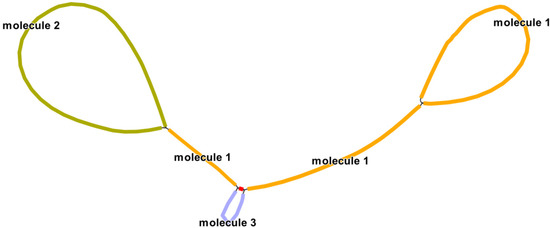
Figure 1.
Branched conformation of Q. acutissima mitogenome.
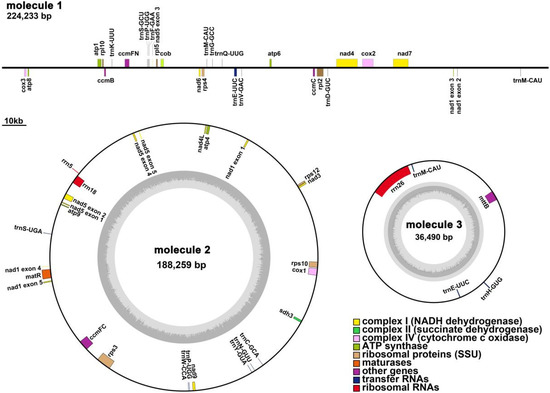
Figure 2.
Q. acutissima mitogenome gene map. Genes shown on the outside and inside of the circle are transcribed clockwise and counterclockwise, respectively. The dark gray region in the inner circle depicts GC content.
The Q. acutissima mitogenome was annotated with 32 PCGs (including 24 unique mitochondrial core and 8 non-core genes), 16 tRNA genes (trnE-UUC, trnM-CAU, and trnP-UGG are multi-copy), and 3 rRNA genes (Table S1). Among the 32 PCGs, 10 contained introns (rpl2, cox2, nad1, rps3, ccmFC, rps10 and nad5 had a single intron, nad4 contained three introns, nad2 and nad7 had four introns), while two genes (nad1 and nad5) were trans-spliced. The core genes include five ATP synthase genes (atp1, atp4, atp6, atp8, and atp9), nine NADH dehydrogenase genes (nad1, nad2, nad3, nad4, nad4L, nad5, nad6, nad7, and nad9), four ubiquinol cytochrome c reductase genes (ccmB, ccmC, ccmFc, and ccmFn), three cytochrome c oxidase genes (cox1, cox2, and cox3), one transport membrane protein gene (mttB), one maturases gene (matR), and one cytochrome c biogenesis gene (cob). Non-core genes include three large subunit of ribosome genes (rpl2, rpl5, and rpl10), four small subunit of ribosome genes (rps3, rps4, rps10, and rps12), and one succinate dehydrogenase gene (sdh3).
3.2. PCGs Codon Usage Analysis
The codon usage analysis of 32 PCGs was performed, and the codon usage of each amino acid is shown in Table S2. Codons (RSCU > 1) were considered to be used preferentially by amino acids. As shown in Figure 3, in addition to the RSCU values of 1 for both the start codon AUG (Met) and UGG (Trp), there is also a general codon usage preference for the mitochondrial PCGs. GCU (Ala), UAU (Tyr), and CAU (His) were the three most frequent codons in Q. acutissima.
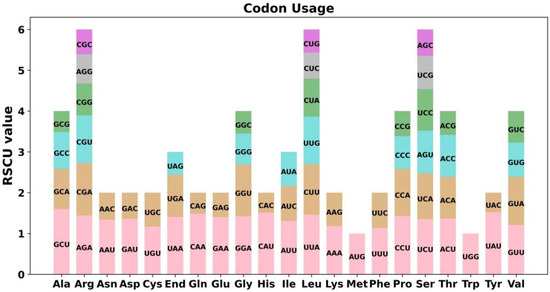
Figure 3.
Q. acutissima mitogenome relative synonymous codon usage (RSCU). Codon families are shown on the x-axis. RSCU values are the number of times a particular codon is observed relative to the number of times that codon would be expected for a uniform synonymous codon usage.
3.3. Q. acutissima Mitogenome Repeats Analysis
A total of 3, 79, 68, and 11 SSRs were found in molecule 1, 2, and 3, respectively (Figure 4), and SSRs in monomeric and dimeric forms accounted for 41.77, 44.12, and 72.73% of the total SSRs, respectively. In molecule 1, thymine (T) monomeric repeats accounted for 52.94 % (9) of the 17 monomeric SSRs, TA repeats accounted for 31.25 % of the dimeric SSRs, and there were no hexameric SSRs. In addition, there were 12 tandem repeats with a match greater than 67% and length between 13 and 22 bp, and 58 pairs of interspersed repeats with length greater than or equal to 30 were observed, including 30 pairs of direct repeats (the longest being 216 bp) and 28 pairs of palindromic repeats. In molecule 2, thymine (T) monomeric repeats accounted for 43.75% (7) of the 16 monomeric SSRs, AT repeats accounted for 35.71% of the dimeric SSRs, and there were no hexameric SSRs. In addition, there were 16 tandem repeats with matches greater than 70% and lengths between 13 and 30 bp, and a total of 65 pairs of interspersed repeats with lengths greater than or equal to 30 were observed, including 48 pairs of direct repeats (the longest being 112 bp) and 17 pairs of palindromic repeats. In molecule 3, adenine (A) monomeric repeats accounted for 60.00% (3) of the 5 monomeric SSRs, and there were no trimeric, pentameric or hexameric SSRs. In addition, there were three tandem repeats with a match greater than 81% and a length between 18 and 22 bp, and a total of seven pairs of interspersed repeats with a length greater than or equal to 30 were observed, including four pairs of direct repeats (the longest being 35 bp) and three pairs of palindromic repeats.
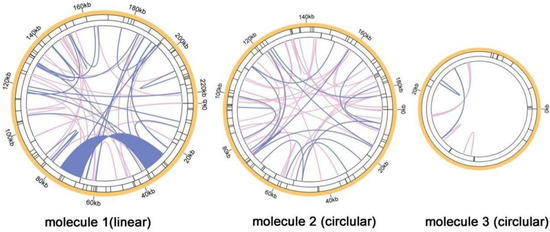
Figure 4.
Q. acutissima mitogenome repeated sequence diagram. The colored line on the innermost circle connects two repeated sequences of interspersed repeats. The black line segments on the second circle and on the outermost circle denote tandem repeat and SSR, respectively.
3.4. Detection of Genome Recombination
There are not many repeated sequences in the Q. acutissima mitogenome, most of which are short in length, and no evidence of recombination was detected. However, evidence of recombination was detected for two pairs of longer repeats (Table 1). The length of the repeated sequence R1 is 10,578 bp; due to the limited length of ONT data, only 19 and eight long reads were detected to support the primary and secondary conformations, respectively. The two units of R1 are located on the molecule 1 (Figure 5), which allows the region between the two repeat units to be inverted. Another pair of repeated sequences R2 is 1679 bp in length, and due to the relatively short length, 224 and 182 long reads were detected to support the primary and secondary conformations, respectively. This indicates a high frequency of recombination occurring in this region. The R2 can mediate the formation of independent circular molecule 3 or integration of molecule 3 onto molecule1, but the proportion of the former is higher.

Table 1.
Recombination frequency of the Q. acutissima mitogenome related to two long repeats.
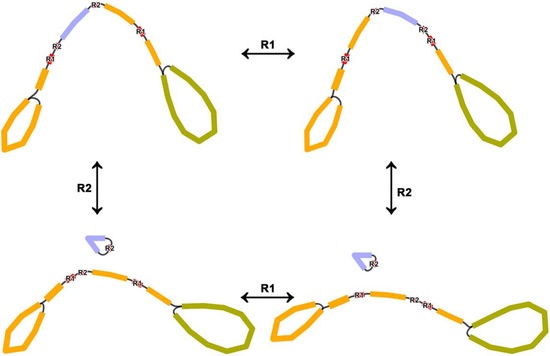
Figure 5.
Two pairs of long repeated sequences are involved in mediating Q. acutissima mitogenome reorganization. The orange node represents molecule 1, the yellow–green contig represents molecule 2, and the blue node represents molecule 3.
3.5. Chloroplast to Mitochondrion DNA Transformation
According to the sequence similarity analysis, a total of 23 fragments were homologous to the mitogenome and chloroplast genome, with a total length of 15,688 bp, accounting for 3.49% of the total length of the mitogenome (Figure 6, Table 2). Among them, four fragments exceeded 1000 bp, with fragments 1 and 2 being the longest at 4760 bp. By annotating these homologous sequences, 13 complete genes were identified, including 2 PCGs (petL, petG), 10 tRNA genes (trnV-GAC, trnI-GAU, trnA-UGC, trnD-GUC, trnM-CAU, trnI-CAU, trnW-CCA, trnP-UGG, trnN-GUU, trnH-GUG), and 1 rRNA gene (rrn16S).
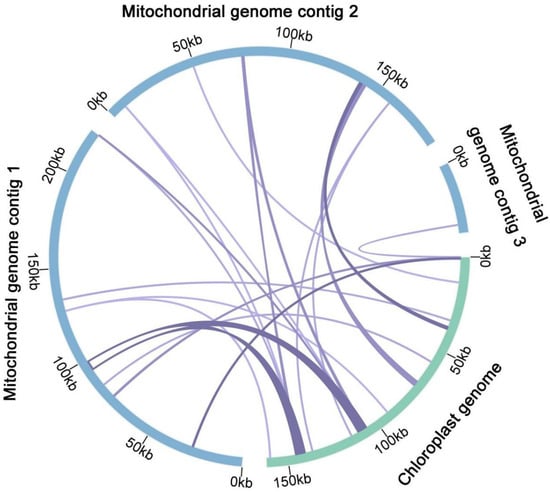
Figure 6.
Schematic representation of gene transfers between chloroplast and mitogenomes in Q. acutissima. The blue and green arcs represent the mitogenome and chloroplast genome, respectively, and the purple lines between the arcs correspond to genomic fragments that are homologous.

Table 2.
Fragments transferred from chloroplasts to mitochondria in Q. acutissima.
3.6. The Prediction of RNA Editing
A total of 466 potential RNA editing sites were identified on 32 mitochondrial PCGs based on the online website PREP suit for the prediction of RNA editing events at a cutoff value = 0.2 criterion, all of which were C-T(U) edits (Figure 7). The predicted RNA editing sites in each gene are shown in Figure 7. On the mitochondrial genes, 38 RNA editing sites were identified for both ccmFN and nad4 genes, which were the most among all genes. The next highest number was 32 for ccmB.
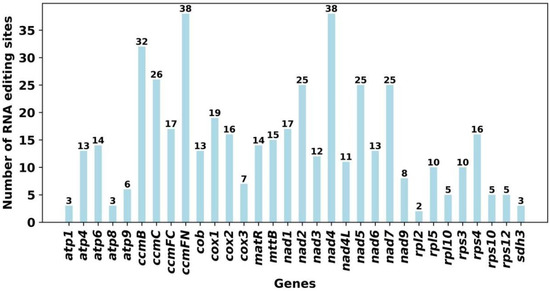
Figure 7.
Number of RNA editing sites predicted by individual PCGs in mitochondria.
3.7. Synteny and Phylogenetic Analysis
As shown in Figure 8, a positive repeat sequence of approximately 10 kb in length was identified in the Q. acutissima mitogenome by dot-plot analysis. The largest co-linear blocks of nearly 20 kb were identified in the dot plot with Fagus sylvatica L., and larger co-linear blocks were identified in the dot plot with Juglans mandshurica Maxim. and A. thaliana, but they were smaller than 20 kb. A large number of homologous co-linear blocks were detected between Q. acutissima and the closely related species (Figure 9). The results indicate that the co-linear blocks are not arranged in the same order among individual mitogenomes; that is, the Q. acutissima mitogenome has undergone extensive genomic rearrangements with closely related species, and the mitogenomes is extremely unconserved in structure.
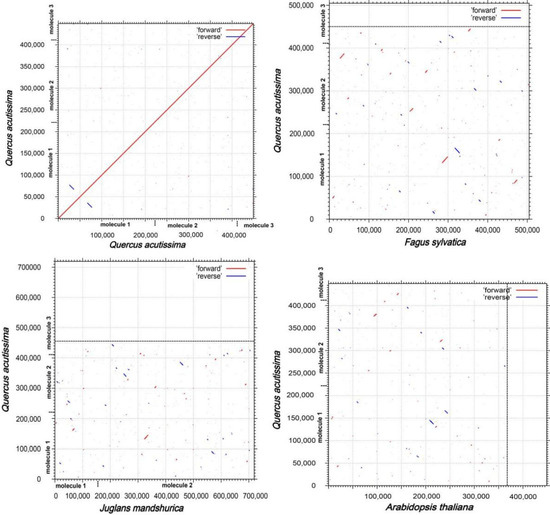
Figure 8.
Dot-plots analysis. Self-dot plot of Q. acutissima is shown in the upper left corner, and the rest are dot plots of Q. acutissima with F. sylvatica, J. mandshurica, and A. thaliana.
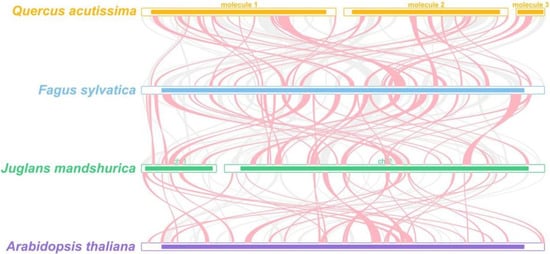
Figure 9.
Mitogenome synteny. Bars indicated the mitogenomes, and the ribbons showed the homologous sequences between the adjacent species. The red areas indicate where the inversion occurred, the gray areas indicate regions of good homology. Common blocks less than 0.5 kb in length are not retained, and regions that fail to have a common block indicate that they are unique to the species. A. thaliana was also compared.
Due to the genome’s low substitution rate, mitochondrial genes are a valuable source of information for phylogenetic analysis at a high taxonomic level [45]. In order to determine the phylogenetic position of Q. acutissima, we used the mitogenome sequences of 29 angiosperm species from GenBank based on the sequences of 14 conserved mitochondrial PCGs to construct a phylogenetic tree, with A. thaliana as the outgroup (Figure 10). Based on a relatively high support rate and in line with the latest classification of APG (Angiosperm Phylogeny Group), Q. acutissima belonged to the family Fagaceae of the order Fagales and is closely related to F. sylvatica.
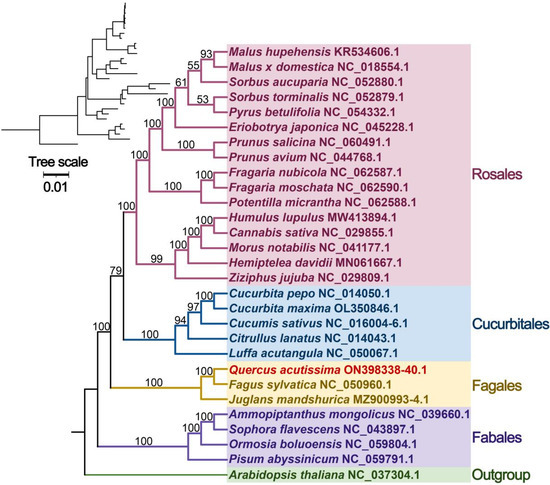
Figure 10.
Phylogenetic tree of 29 angiosperms based on the sequences of 14 conserved mitochondrial PCGs. The A. thaliana was chosen as the outgroup. The number at each node is the bootstrap probability.
4. Discussion
Mitochondria are important organelles in eukaryotic cells, providing energy for various cells physiological activities. In fact, plant mitogenomes are more complex than those of animals, with extensive size variation, sequence alignment, repetitive content, and highly conserved coding sequences [12,21], and many mitogenome sequences of plants have been reported [46,47,48]. Although plant mitogenomes are often assembled and displayed as circular maps, plant mitochondrial DNA does, most likely, not exist as one large circular DNA molecule but mostly as a complex and dynamic collection of linear DNA with combinations of smaller circular and branched DNA molecules [21,49,50,51,52]. In the entire order of the Fagales, the assembled mitogenome sequences of three species have been made public: Quercus variabilis Blume (GenBank MN199236, unverified) [53], Betula pendula Roth. (GenBank LT855379.1, not annotated) [54], and F. sylvatica (GenBank NC050960.1) [55]. The total Q. acutissima mitogenome length of 448,982 bp is between the Q. variabilis (same family, same genus) (412,886 bp) and the F. sylvatica (same family, different genus) (504,715 bp), while B. pendula (same order, different family) is the longest (581,505 bp). The GC content is an important factor in the assessment of species [56], the GC content of the Q. acutissima mitogenome was 45.72%, which was close to the GC content of the Q. variabilis mitogenome (45.76%) and F. sylvatica mitogenome (45.8%). The F. sylvatica mitogenome may fit best in a circular display, which is not corresponding to the physical structure of the genome in vivo, where it is more likely to exist in different conformations [55]. In the present study, the Q. acutissima mitogenome is a branched structure of two circular molecules and one linear molecule; however, the coexistence of these molecules needs to be further investigated.
There are 64 codons in the eukaryotic genome, and there is a wide variation in the rate of genomic codon usage among different species and organisms. This preference is thought to be the result of a relative equilibrium that gradually develops within the cell over a long period of evolutionary selection. In Q. acutissima, most PCGs were the typical ATG start codon, and the distribution of amino acid compositions was similar to other angiosperms [57,58].
Repeated sequences are widely present in the mitogenome and can be divided into two main categories: tandem and interspersed repeats [59]. Repeated sequences in the mitogenome are often critical for intermolecular recombination, and in general, the largest repeats within a species (usually more than about 1 kb in angiosperms) have been found to recombine constitutively, leading to isomerization [51,60]. The longest interspersed repeat sequence in the Q. acutissima mitogenome exceeded 1 kb (10,578 bp in size) and may be responsible for heterodimerization. In comparison, the longest repeat sequence of Q. variabilis mitogenome is 17.3 kb in size, the longest F. sylvatica repeat is 918 bp, while the longest repeat existed in B. pendula is only 474 bp.
Homologous recombination mediated by repeats is almost universal in plant mitogenomes [61,62]. It has been reported that the size of the repeats is closely related to the frequency of recombination [63]; namely, the frequency of recombination mediated by short repeats tends to be lower than that mediated by long repeats. For example, in Nymphaea colorata Peter [64], Scutellaria tsinyunensis C. Y. Wu et S. Chow [65] and Abelmoschus esculentus (L.) Moench [66], the long repeats had high recombination frequencies, and the short repeats had lower recombination frequencies; all of the repeats identified in the Prunus salicina Lindl. [67] mitogenome were short repeats, and they all had low recombination frequency. In the Q. acutissima mitogenome, we found two pairs of long repeats that also had a high frequency of recombination, but some potential repeats involved in recombination have not been discovered.
During mitochondrial evolution, some chloroplast fragments migrate into the mitogenome, and the length and sequence similarity of the migrated fragments vary between species [12]. We found 23 fragments that were homologous to the chloroplast genome and mitogenome, with a total of 13 complete, 2 PCGs, 10 tRNA, and 1 rRNA genes. The transfer of tRNA genes from chloroplasts to mitochondria is common in angiosperms [68].
In plants, RNA editing is required for gene expression, and cytidine (C)-to-uridine (U) RNA editing is enriched in mitochondrial and chloroplast genomes [56]. Studying RNA editing sites helps to understand the expression of mitochondrial and chloroplast genes in plants. Previous research had uncovered approximately 491 RNA editing sites within 34 genes in Oryza sativa L. [48], 486 within 31 genes in Phaseolus vulgaris L. [14], and 421 within 26 genes in Acer truncatum Bunge [56]. In this study, 466 RNA editing sites were identified in 32 PCGs based on online site prediction, all of which exhibited C-U RNA editing. The number of RNA editing sites varied greatly among genes, but the largest numbers of cytochrome c biogenesis and NADH dehydrogenase genes were similar to those of A. truncatum and P. vulgaris. The identification of RNA editing sites provides clues to predicting the gene function of new codons.
The covariance study is the arrangement of homologous genes or sequences, and the results showed that a large number of homologous covariance blocks were detected between Q. acutissima and F. sylvatica, J. mandshurica and A. thaliana, among which the largest covariance block with F. sylvatica was nearly 20 kb, while the larger covariance blocks with J. mandshurica and A. thaliana were less than 20 kb. The inconsistent order of the co-linear blocks’ arrangement suggests that Q. acutissima mitogenome has undergone extensive genomic rearrangements from them and is extremely unconserved in structure, which should be the main reason for the evolution and diversification of Q. acutissima mitogenome. The Q. acutissima chloroplast genome was shown to be more conservative with similar characteristics to other genus Quercus species, and analysis of the phylogenetic relationships was found Q. acutissima to be closely related to Q. variabilis [25]. In this study, we further analyzed the phylogenetic relationships of Q. acutissima based on mitochondrial genomic information and constructed a sequence phylogenetic tree using PCGs. The results indicated that the affinity between Q. acutissima and F. sylvatica is closer.
5. Conclusions
Here, we assembled and annotated the Q. acutissima mitogenome and performed extensive analyses based on DNA and amino acid sequences of annotated genes. The total length of Q. acutissima mitogenome is 448,982 bp, with 45.72% GC content. The mitogenome main structure is branched, including linear molecule 1, circular molecule 2, and circular molecule 3, but whether these molecules coexist needs further study. We annotated 32 PCGs, including 24 unique mitochondrial core and 8 non-core, 16 tRNA, and 3 rRNA genes. Additionally, the codon usage, repeated sequences, genome recombination, chloroplast to mitochondrion DNA transformation, RNA editing, and synteny were also analyzed. Phylogenetic trees based on the mitogenomes of 29 species contributed to the scientific classification of Q. acutissima. This study provided information on the genetic characteristics, phylogenetic relationships, and evolution of Q. acutissima as well as serves as a basis for species identification and biological research in Fagaceae.
Supplementary Materials
The following supporting information can be downloaded at: https://www.mdpi.com/article/10.3390/genes13081321/s1, Table S1: Gene composition in the Q. acutissima mitogenome; Table S2: RSCU for each amino acid pair in the Q. acutissima mitogenome.
Author Contributions
D.L. and H.G. contributed equally to this work. Conceptualization, Methodology, Writing—Original Draft Preparation: D.L. and H.G.; Data Analysis: J.Z., Y.C. and Y.G.; Resource Investigation: K.Q., P.D., H.Y. and T.X., Sample collection: Q.J. and S.H.; Writing—Review and Editing: W.L. and B.T. All authors have read and agreed to the published version of the manuscript.
Funding
This research was funded by the Q. variabilis Excellent Germplasm Resources Collection and Breeding Technology Research (No. CAFYBB2018ZB001-11), the Biosafety and Genetic Resources Management Project of State Forestry and Grassland Administration “Collection and arrangement of genetic resources and genetic diversity evaluation of Q. acutissima (No. KJZXSA202111)”, the Subject of Key R & D Plan of Shandong Province (Major Scientific and Technological Innovation Project) “Mining and Accurate Identification of Forest Tree Germplasm Resources (No. 2021LZGC023)”, and Project of National Forest Germplasm Resources Sharing Service Platform Construction and Operation (No. 2005-DKA21003).
Institutional Review Board Statement
Not applicable.
Informed Consent Statement
Not applicable.
Data Availability Statement
Publicly available datasets were analyzed in this study. These data can be found here: GenBank Accession Nos. MZ636519.
Conflicts of Interest
The authors declare no conflict of interest. The funders had no role in the design of the study; in the collection, analyses, or interpretation of data; in the writing of the manuscript; or in the decision to publish the results.
References
- Zhang, H. Study on Population Genetics and Demographic History of the Three Closely Related Species of Section Aegilops Occurred in China; Northwest University: Xi’an, China, 2018. [Google Scholar]
- Zhang, X.; Li, Y.; Fang, Y. Geographical Distribution and Prediction of Potential Ranges of Quercus acutissima in China. Acta Bot. Boreali-Occident. Sin. 2014, 34, 1685–1692. [Google Scholar]
- Ge, L.; Cheng, X.; Duan, X.; Yu, M.; Liu, Z. Effects of fertilization on the carbon density of sawtooth oak plantations and the soil respi-ration in dormant period. Chin. J. Ecol. 2012, 31, 248–253. [Google Scholar]
- Li, Y. Genetic Structure and Evolutionary History of Chinese Oak Species in Quercus Section Cerris; Nanjing Forestry University: Nanjing, China, 2019. [Google Scholar]
- Tan, Z.Y.; Tang, H.F. Cultivation technology of native species of Quercus acutissima. For. Ecol. 2022, 1, 38–39. [Google Scholar]
- Ye, N.; Wang, X.; Li, J.; Bi, C.; Xu, Y.; Wu, D.; Ye, Q. Assembly and comparative analysis of complete mitochondrial genome sequence of an economic plant Salix suchowensis. PeerJ 2017, 5, e3148. [Google Scholar] [CrossRef] [PubMed] [Green Version]
- Birky, C.W. Uniparental inheritance of mitochondrial and chloroplast genes: Mechanisms and evolution. Proc. Natl. Acad. Sci. USA 1995, 92, 11331–11338. [Google Scholar] [CrossRef] [PubMed] [Green Version]
- Ogihara, Y.; Yamazaki, Y.; Murai, K.; Kanno, A.; Terachi, T.; Shiina, T.; Miyashita, N.; Nasuda, S.; Nakamura, C.; Mori, N.; et al. Structural dynamics of cereal mitochondrial genomes as revealed by complete nucleotide sequencing of the wheat mitochondrial genome. Nucleic Acids Res. 2005, 33, 6235–6250. [Google Scholar] [CrossRef] [PubMed] [Green Version]
- Kroemer, G.; Reed, J.C. Mitochondrial control of cell death. Nat. Med. 2000, 6, 513–519. [Google Scholar] [CrossRef] [PubMed]
- van Loo, G.; Saelens, X.; van Gurp, M.; MacFarlane, M.; Martin, S.J.; Vandenabeele, P. The role of mitochondrial factors in apoptosis: A Russian roulette with more than one bullet. Cell Death Differ. 2002, 9, 1031–1042. [Google Scholar] [CrossRef]
- Bonora, M.; De Marchi, E.; Patergnani, S.; Suski, J.M.; Celsi, F.; Bononi, A.; Giorgi, C.; Marchi, S.; Rimessi, A.; Duszynski, J.; et al. Tumor necrosis factor-α impairs oligodendroglial differentiation through a mitochondria-dependent process. Cell Death Differ. 2014, 21, 1198–1208. [Google Scholar] [CrossRef] [Green Version]
- Cheng, Y.; He, X.; Priyadarshani, S.V.G.N.; Wang, Y.; Ye, L.; Shi, C.; Ye, K.; Zhou, Q.; Luo, Z.; Deng, F.; et al. Assembly and comparative analysis of the complete mitogenomes of Suaeda Glauca. BMC Genom. 2021, 22, 167. [Google Scholar] [CrossRef]
- Wallace, D.C.; Singh, G.; Lott, M.T.; Hodge, J.A.; Schurr, T.G.; Lezza, A.M.S.; Elsas II, L.J.; Nikoskelainen, E.K. Mitochondrial DNA mutation associated with Leber’s hereditary optic neuropathy. Science 1988, 242, 1427–1430. [Google Scholar] [CrossRef] [PubMed]
- Bi, C.; Lu, N.; Xu, Y.; He, C.; Lu, Z. Characterization and Analysis of the Mitochondrial Genome of Common Bean (Phaseolus vulgaris) by Comparative Genomic Approaches. Int. J. Mol. Sci. 2020, 21, 3778. [Google Scholar] [CrossRef] [PubMed]
- Skippington, E.; Barkman, T.J.; Rice, D.W.; Palmer, J.D. Miniaturized mitogenome of the parasitic plant Viscum scurruloideum is extremely divergent and dynamic and has lost all nad genes. Proc. Natl. Acad. Sci. USA 2015, 112, E3515–E3524. [Google Scholar] [CrossRef] [PubMed] [Green Version]
- Sloan, D.B.; Alverson, A.J.; Chuckalovcak, J.P.; Wu, M.; McCauley, D.E.; Palmer, J.D.; Taylor, D.R. Rapid Evolution of Enormous, Multichromosomal Genomes in Flowering Plant Mitochondria with Exceptionally High Mutation Rates. PLoS Biol. 2012, 10, e1001241. [Google Scholar] [CrossRef] [PubMed] [Green Version]
- Mower, J.P.; Sloan, D.B.; Alverson, A.J. Plant Mitochondrial Genome Diversity: The Genomics Revolution; Springer: Heidelberg, Austria, 2012; Volume 1, pp. 123–144. [Google Scholar]
- Burger, G.; Gray, M.W.; Franz Lang, B. Mitochondrial genomes: Anything goes. Trends Genet. 2003, 19, 709–716. [Google Scholar] [CrossRef] [PubMed]
- Christiane, F.; Mark, C.; Yan, G.; Barry, M. The maize mitochondrial genome: Dynamic, yet functional. Trends Genet. 1995, 11, 228–235. [Google Scholar]
- Wang, S.B.; Li, D.W.; Yao, X.H.; Song, Q.W.; Wang, Z.P.; Zhang, Q.; Zhong, C.; Liu, Y.; Huang, H. Evolution and diversification of kiwifruit mitogenomes through extensive whole-genome rearrangement and mosaic loss of intergenic sequences in a highly variable region. Genome Biol. Evol. 2019, 11, 1192–1206. [Google Scholar] [CrossRef]
- Kozik, A.; Rowan, B.A.; Lavelle, D.; Berke, L.; Schranz, M.E.; Michelmore, R.W.; Christensen, A.C. The alternative reality of plant mitochondrial DNA: One ring does not rule them all. PLOS Genet. 2019, 15, e1008373. [Google Scholar] [CrossRef] [Green Version]
- Jackman, S.D.; Lauren, C.; Warren, R.L.; Heather, K.; Eva, T.; MacLeod, T.; Pleasance, S.; Pandoh, P.; Zhao, Y.; Coope, R.J.; et al. Complete mitochondrial genome of a gymnosperm, Sitka spruce (Picea sitchensis), indicates a complex physical structure. Genome Biol. Evol. 2020, 12, 1174–1179. [Google Scholar] [CrossRef]
- Petit, R.J.; Csaikl, U.M.; Bordacs, S.; Burg, K.; Coart, E.; Cottrell, J.; Dam, B.; Deans, J.D.; Dumolin-Lapegue, S.; Fineschi, S.; et al. Corrigendum to “Chloroplast DNA variation in European white oaks phylogeography and patterns of diversity based on data from over 2600 populations”. For. Ecol. Manag. 2003, 176, 595–599. [Google Scholar] [CrossRef]
- Meng, X. Study on Phylogeography and Population Genetics Structure in Quercus Acutissima Carr; Northwest University: Xi’an, China, 2017. [Google Scholar]
- Li, X.; Li, Y.; Zang, M.; Li, M.; Fang, Y. Complete Chloroplast Genome Sequence and Phylogenetic Analysis of Quercus acutissima. Int. J. Mol. Sci. 2018, 19, 2443. [Google Scholar] [CrossRef] [PubMed] [Green Version]
- Jin, J.J.; Yu, W.B.; Yang, J.B.; Song, Y.; dePamphilis, C.W.; Yi, T.S.; Li, D.Z. GetOrganelle: A fast and versatile toolkit for accurate de novo assembly of organelle genomes. Genome Biol. 2020, 21, 241. [Google Scholar] [CrossRef] [PubMed]
- Wick, R.R.; Schultz, M.B.; Zobel, J.; Holt, K.E. Bandage: Interactive visualization of de novo genome assemblies. Bioinformatics 2015, 31, 3350–3352. [Google Scholar] [CrossRef] [PubMed] [Green Version]
- Li, H.; Durbin, R. Fast and accurate short read alignment with Burrows-Wheeler transform. Bioinformatics 2009, 25, 1754–1760. [Google Scholar] [CrossRef] [PubMed] [Green Version]
- Michael, T.; Pascal, L.; Tommaso, P.; Elena, S.U.J.; Axel, F.; Ralph, B.; Stephan, G. GeSeq-versatile and accurate annotation of organelle genomes. Nucleic Acids Res. 2017, 45, W6–W11. [Google Scholar]
- Lowe, T.M.; Eddy, S.R. tRNAscan-SE: A program for improved detection of transfer RNA genes in genomic sequence. Nucleic Acids Res. 1997, 25, 955–964. [Google Scholar] [CrossRef]
- Chen, Y.; Ye, W.; Zhang, Y.; Xu, Y. High speed BLASTN: An accelerated MegaBLAST search tool. Nucleic Acids Res. 2015, 43, 7762–7768. [Google Scholar] [CrossRef] [Green Version]
- Lewis, S.E.; Searle, S.; Harris, N.; Gibson, M.; Iyer, V.; Richter, J.; Wiel, C.; Bayraktaroglu, L.; Birney, E.; Crosby, M.A. Apollo: A sequence annotation editor. Genome Biol. 2002, 3, research0082. [Google Scholar] [CrossRef]
- Zhang, D.; Gao, F.; Li, W.X.; Jakovlić, I.; Zou, H.; Zhang, J.; Wang, G.T. PhyloSuite: An integrated and scalable desktop platform for streamlined molecular sequence data management and evolutionary phylogenetics studies. Mol. Ecol. Resour. 2020, 20, 348–355. [Google Scholar] [CrossRef]
- Kumar, S.; Stecher, G.; Tamura, K. MEGA7: Molecular evolutionary genetics analysis version 7. 0 for bigger datasets. Mol. Biol. Evol. 2016, 33, 1870–1874. [Google Scholar] [CrossRef] [Green Version]
- Beier, S.; Thiel, T.; Münch, T.; Scholz, U.; Mascher, M. MISA-web: A web server for microsatellite prediction. Bioinformatics 2017, 33, 2583–2585. [Google Scholar] [CrossRef] [PubMed] [Green Version]
- Benson, G. Tandem repeats finder: A program to analyze DNA sequences. Nucleic Acids Res. 1999, 27, 573–580. [Google Scholar] [CrossRef] [PubMed] [Green Version]
- Kurtz, S.; Choudhuri, J.V.; Ohlebusch, E.; Schleiermacher, C.; Stoye, J.; Giegerich, R. REPuter: The manifold applications of repeat analysis on a genomic scale. Nucleic Acids Res. 2001, 29, 4633–4642. [Google Scholar] [CrossRef] [PubMed] [Green Version]
- Zhang, H.; Meltzer, P.; Davis, S. RCircos: An R package for Circos 2D track plots. BMC Bioinform. 2013, 14, 244. [Google Scholar] [CrossRef] [PubMed] [Green Version]
- Shi, L.; Chen, H.; Jiang, M.; Wang, L.Q.; Wu, X.; Huang, L.F.; Liu, C. CPGAVAS2, an integrated plastome sequence annotator and analyzer. Nucleic Acids Res. 2019, 47, W65–W73. [Google Scholar] [CrossRef] [PubMed]
- Mower, J.P. The PREP suite: Predictive RNA editors for plant mitochondrial genes, chloroplast genes and user-defined alignments. Nucleic Acids Res. 2009, 37, W253–W259. [Google Scholar] [CrossRef]
- Wang, Y.; Tang, H.; DeBarry, J.D.; Tan, X.; Li, J.; Wang, X.; Lee, T.-H.; Jin, H.; Marler, B.; Guo, H.; et al. MCScanX: A toolkit for detection and evolutionary analysis of gene synteny and collinearity. Nucleic Acids Res. 2012, 40, e49. [Google Scholar] [CrossRef] [Green Version]
- Katoh, K.; Standley, D.M. MAFFT Multiple Sequence Alignment Software Version 7: Improvements in Performance and Usability. Mol. Biol. Evol. 2013, 30, 772–780. [Google Scholar] [CrossRef] [Green Version]
- Huelsenbeck, J.P.; Ronquist, F. MRBAYES: Bayesian inference of phylogenetic trees. Bioinformatics 2001, 17, 754–755. [Google Scholar] [CrossRef] [Green Version]
- Letunic, I.; Bork, P. Interactive Tree Of Life (iTOL) v4: Recent updates and new developments. Nucleic Acids Res. 2019, 47, W256–W259. [Google Scholar] [CrossRef] [Green Version]
- Hiesel, R.; Haseler, A.V.; Brennicke, A. Plant Mitochondrial Nucleic Acid Sequences as a Tool for Phylogenetic Analysis. Proc. Natl. Acad. Sci. USA 1994, 91, 634–638. [Google Scholar] [CrossRef] [PubMed] [Green Version]
- Unseld, M.; Marienfeld, J.R.; Brandt, P.; Brennicke, A. The mitochondrial genome of Arabidopsis thaliana contains 57 genes in 366,924 nucleotides. Nat. Genet. 1997, 15, 57–61. [Google Scholar] [CrossRef] [PubMed]
- Notsu, Y.; Masood, S.; Nishikawa, T.; Kubo, N.; Akiduki, G.; Nakazono, M.; Hirai, A.; Kadowaki, K. The complete sequence of the rice (Oryza sativa L.) mitochondrial genome: Frequent DNA sequence acquisition and loss during the evolution of fowering plants. Mol. Gen. Genom. 2002, 268, 434–445. [Google Scholar] [CrossRef] [PubMed]
- Clifton, S.W.; Minx, P.; Fauron, C.M.-R.; Gibson, M.; Allen, J.O.; Sun, H.; Thompson, M.; Barbazuk, W.B.; Kanuganti, S.; Tayloe, C.; et al. Sequence and Comparative Analysis of the Maize NB Mitochondrial Genome. Plant Physiol. 2004, 136, 3486–3503. [Google Scholar] [CrossRef] [PubMed] [Green Version]
- Morley, S.A.; Nielsen, B.L. Plant mitochondrial DNA. Front. Biosci. 2017, 22, 1023–1032. [Google Scholar]
- Oldenburg, D.J.; Bendich, A.J. DNA maintenance in plastids and mitochondria of plants. Front. Plant Sci. 2015, 6, 883. [Google Scholar] [CrossRef] [Green Version]
- Wynn, E.L.; Christensen, A.C. Repeats of Unusual Size in Plant Mitochondrial Genomes: Identification, Incidence and Evolution. G3-Genes Genom. Genet. 2018, 9, 549–559. [Google Scholar] [CrossRef] [Green Version]
- Backert, S.; Nielsen, B.L.; Borner, T. The mystery of the rings: Structure and replication of mitochondrial genomes from higher plants. Trends Plant Sci. 1997, 2, 477–483. [Google Scholar] [CrossRef]
- Bi, Q.; Li, D.; Zhao, Y.; Wang, M.; Li, Y.; Liu, X.; Wang, L.; Yu, H. Complete mitochondrial genome of Quercus variabilis (Fagales, Fagaceae). Mitochondrial DNA Part B 2019, 4, 3927–3928. [Google Scholar] [CrossRef] [Green Version]
- Salojarvi, J.; Smolander, O.P.; Nieminen, K.; Rajaraman, S.; Safronov, O.; Safdari, P.; Lamminmäki, A.; Immanen, J.; Lan, T.; Tanskanen, J.; et al. Genome sequencing and population genomic analyses provide insights into the adaptive landscape of silver birch. Nat. Genet. 2017, 49, 904–912. [Google Scholar] [CrossRef]
- Mader, M.; Schroeder, H.; Schott, T.; Schning-Stierand, K.; Montalvão, A.P.L.; Liesebach, H.; Liesebach, M.; Fussi, B.; Kersten, B. Mitochondrial genome of Fagus sylvatica L. as a source for taxonomic marker development in the fagales. Plants 2020, 9, 1274. [Google Scholar] [CrossRef] [PubMed]
- Ma, Q.; Wang, Y.; Li, S.; Wen, J.; Zhu, L.; Yan, K.; Du, Y.; Ren, J.; Li, S.; Chen, Z.; et al. Assembly and comparative analysis of the first complete mitochondrial genome of Acer truncatum Bunge: A woody oil-tree species producing nervonic acid. BMC Plant Biol. 2022, 22, 29. [Google Scholar] [CrossRef] [PubMed]
- Yang, J.; Wariss, H.M.; Tao, L.; Zhang, R.; Yun, Q.; Hollingsworth, P.; Dao, Z.; Luo, G.; Guo, H.; Ma, Y.; et al. De novo genome assembly of the endangered Acer yangbiense, a plant species with extremely small populations endemic to Yunnan Province, China. GigaScience 2019, 8, giz085. [Google Scholar] [CrossRef] [PubMed] [Green Version]
- Sloan, D.; Wu, Z.; Sharbrough, J. Correction of persistent errors in Arabidopsis reference mitochondrial genomes. Plant Cell 2018, 30, 525–527. [Google Scholar] [CrossRef] [Green Version]
- Gualberto, J.M.; Mileshina, D.; Wallet, C.; Niazi, A.K.; Weber-Lotfi, F.; Dietrich, A. The plant mitochondrial genome: Dynamics and maintenance. Biochimie 2014, 100, 107–120. [Google Scholar] [CrossRef]
- Guo, W.; Grewe, F.; Fan, W.; Young, G.J.; Knoop, V.; Palmer, J.D.; Mower, J.P. Ginkgo and Welwitschia Mitogenomes reveal extreme contrasts in gymnosperm mitochondrial evolution. Mol. Biol. Evol. 2016, 33, 1448–1460. [Google Scholar] [CrossRef] [PubMed] [Green Version]
- Cheng, L.; Wang, W.; Yao, Y.; Sun, Q. Mitochondrial RNase H1 activity regulates R-loop homeostasis to maintain genome integrity and enable early embryogenesis in Arabidopsis. PLoS Biol. 2021, 19, e3001357. [Google Scholar] [CrossRef] [PubMed]
- Odahara, M.; Nakamura, K.; Sekine, Y.; Oshima, T. Ultra-deep sequencing reveals dramatic alteration of organellar genomes in Physcomitrella patens due to biased asymmetric recombination. Commun. Biol. 2021, 4, 633. [Google Scholar] [CrossRef]
- Varré, J.-S.; D’Agostino, N.; Touzet, P.; Gallina, S.; Tamburino, R.; Cantarella, C.; Ubrig, E.; Cardi, T.; Drouard, L.; Gualberto, J.M.; et al. Complete Sequence, Multichromosomal Architecture and Transcriptome Analysis of the Solanum tuberosum Mitochondrial Genome. Int. J. Mol. Sci. 2019, 20, 4788. [Google Scholar] [CrossRef] [Green Version]
- Dong, S.; Zhao, C.; Chen, F.; Liu, Y.; Zhang, S.; Wu, H.; Zhang, L.; Liu, Y. The complete mitochondrial genome of the early flowering plant Nymphaea colorata is highly repetitive with low recombination. BMC Genom. 2018, 19, 614. [Google Scholar] [CrossRef]
- Li, J.; Xu, Y.; Shan, Y.; Pei, X.; Yong, S.; Liu, C.; Yu, J. Assembly of the complete mitochondrial genome of an endemic plant, Scutellaria tsinyunensis, revealed the existence of two conformations generated by a repeat-mediated recombination. Planta 2021, 254, 36. [Google Scholar] [CrossRef] [PubMed]
- Li, J.; Li, J.; Ma, Y.; Kou, L.; Wei, J.; Wang, W. The complete mitochondrial genome of okra (Abelmoschus esculentus): Using nanopore long reads to investigate gene transfer from chloroplast genomes and rearrangements of mitochondrial DNA molecules. BMC Genom. 2022, 23, 481. [Google Scholar] [CrossRef] [PubMed]
- Fang, B.; Li, J.; Zhao, Q.; Liang, Y.; Yu, J. Assembly of the Complete Mitochondrial Genome of Chinese Plum (Prunus salicina): Characterization of Genome Recombination and RNA Editing Sites. Genes 2021, 12, 1970. [Google Scholar] [CrossRef] [PubMed]
- Bi, C.; Paterson, A.H.; Wang, X.; Xu, Y.; Wu, D.; Qu, Y.; Jiang, A.; Ye, Q.; Ye, N. Analysis of the complete mitochondrial genome sequence of the diploid cotton Gossypium raimondii by comparative genomics approaches. BioMed Res. Int. 2016, 2016, 5040598. [Google Scholar] [CrossRef] [PubMed] [Green Version]
Publisher’s Note: MDPI stays neutral with regard to jurisdictional claims in published maps and institutional affiliations. |
© 2022 by the authors. Licensee MDPI, Basel, Switzerland. This article is an open access article distributed under the terms and conditions of the Creative Commons Attribution (CC BY) license (https://creativecommons.org/licenses/by/4.0/).